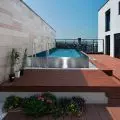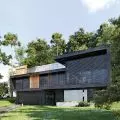Floating farm - pantries of floating settlements
Floating houses are not everything, however. Floating settlements also need infrastructure that can travel with them. One example of the experiments being carried out in the field of mobile agriculture is the Floating Farm project, which is distinguished primarily by the type of activity carried out.
Floating crops have been tested before, and in Rotterdam it was decided to build a floating cow farm. Again - the project's premise is based on the principles of circular economy (building a closed-loop city), reuse, locality and accessibility. The milk-producing farm thus uses urban biomass, which the cows turn into milk. The farm's transparent walls and location allow those interested to observe the entire process. Also, waste from the farm itself, such as manure, is used locally as fertilizer for green spaces.
Designed by Goldsmith's office, the floating farm
© Goldsmith Architects
Designed by Goldsmith's office, the floating farm is primarily a spacious barn with fully automated feeding and milking systems. The roof was designed to collect rainwater as best as possible, and a system separating the dry fraction from the wet fraction of cow manure allows for efficient recycling. The photovoltaic panels that power the farm provide all of its energy needs. The cows also have access to a nearby field via a platform designed for them - so they don't spend their entire lives in a synthetic space lined with rubber. Most of the cattle's food comes from the city, including grains from a local brewery, bran, potato skins and grass from the fields.


































